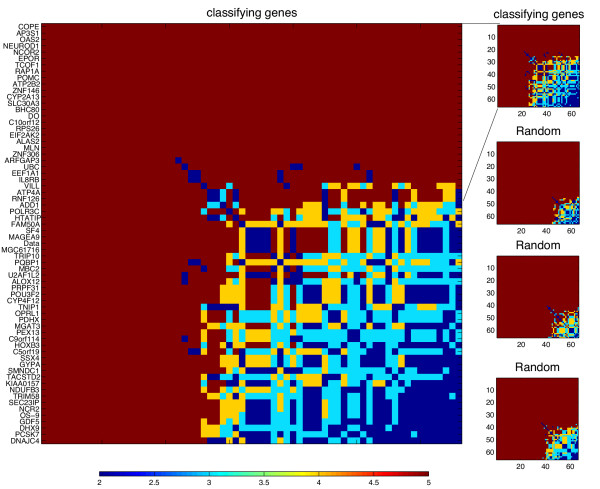Figure 6.

Distance map between the differentially expressed genes in a condition specific (CS) regulatory network. In this map we display the gene-gene distances between the pairs of genes that belong to the subset of differentially expressed genes. To determine the distance between gene a and gene b, we count the number of directed links leading from each TF to genes a and b, and calculate the sum of links of the two paths for each TF. The distance between genes is defined by the minimum of these sums (This also defines the common closest TF ancestor of this pair of genes). We show the distances between the pairs of genes that belong to the subset of differentially expressed genes separating between disease free, node-positive breast cancer patients and patients with recurrence [38]. This map resembles maps used in atlases to represent distances between different cities. The order of the genes on the x and y-axes is the same. The distances between them are color coded in the horizontal bar below the map (distances of 1 or 2 are indicated in blue, distance of 3 in cyan, distance of 4 in yellow and distances greater than 4 in Red. Distances > 4 typically represent disconnection, and in rare cases, long geodesic distances. In this example we identified 66 differentially expressed genes (see list on the y-axis) and found that a large subset of these genes are close to each other on the class collective CS network derived from the patients that have recurrence. This proximity is significant when compared to the proximity obtained by choosing a hundred same size random sets of genes (p < 0.01). This suggests a regulatory association between the differentially expressed genes. To demonstrate the tendency of these genes to be localized on the class collective CS network, we show three examples of distance maps of randomly selected, same size, sets of genes (lower three maps in the right column). The top map on the right of this figure is a scaled down map of the classifying genes, and is identical to the larger map on the left. This phenomenon of localization is not observed in the corresponding disease free collective CS network.
